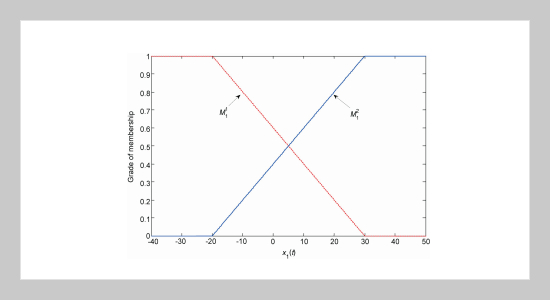REFERENCES
- [1] Tong, S. and Li, H. H., “Observer-Based Robust Fuzzy Control of Nonlinear Systems with Parametric Uncertainties,” Fuzzy Sets Syst., Vol. 131, pp. 165�184 (2002).
- [2] Lee, H. J., Park, J. B. and Chen, G., “Robust Fuzzy Control of Nonlinear Systems with Parametric Uncertainties,” IEEE Trans. Fuzzy Syst., Vol. 9, pp. 369�379 (2001).
- [3] Takagi, T. and Sugeno, M., “Fuzzy Identification of Systems and Its Applications to Modeling and Control,” IEEE Trans. Syst., Man, Cybern., Vol. SMC-15, pp. 116�132 (1985).
- [4] Wong, L. K., Leung, F. H. F. and Tam, P. K. S., “Lyapunov-Function-Based Design of Fuzzy Logic Controller and Its Application on Combining Controllers,” IEEE Trans. Indust. Electron., Vol. 45, pp. 502�509 (1998).
- [5] Wang, H. O., Tanaka, K. and Griffin, M. F., “An Approach to Fuzzy Control of Nonlinear Systems: Stability and Design Issues,” IEEE Trans. Fuzzy Syst., Vol. 4, pp. 14�23 (1996).
- [6] Kiriakidis, K., “Fuzzy Model-Based Control of Complex Plants,” IEEE Trans. Fuzzy Syst., Vol. 6, pp. 517� 529 (1998).
- [7] Lee, H. J., Joo, Y. H., Park, J. B. and Shieh, L. S., “Intelligent Digitally Redesigned PAM Fuzzy Controller for Nonlinear Systems,” Proc. FUZZ-IEEE, Vol. 2, pp. 904�909 (1999).
- [8] Cao, S. G., Rees, N. W. and Feng, G., “H Control of Uncertain Fuzzy Continuous-Time Systems,” Fuzzy Sets Syst., Vol. 115, pp. 171�190 (2000).
- [9] Tanaka, K. and Sano, M., “A Robust Stabilization Problem of Fuzzy Control Systems and Its Application to Backing Up Control of a Truck-Trailer,” IEEE Trans. Fuzzy Syst., Vol. 2, pp. 119�134 (1994).
- [10] Joo, Y. H., Shieh, L. S. and Chen, G., “Hybrid StateSpace Fuzzy Model-Based Controller with Dual-Rate Sampling for Digital Control of Chaotic Systems,” IEEE Trans. Fuzzy Syst., Vol. 7, pp. 394�408 (1999).
- [11] Chang, W., Park, J. B., Joo, Y. H. and Chen, G., “GABased Intelligent Digital Redesign of Fuzzy ModelBased Controller for Dynamical Systems with Uncertainties,” IEEE Trans. Circuit Syst.---I, Vol. 45, pp. 1021�1040 (1998).
- [12] Tanaka, K., Ikeda, T. and Wang, H. O., “Robust Stabilization of a Class of Uncertain Nonlinear Systems via Fuzzy Control: Quadratic Stabilizability, H Control Theory, and Linear Matrix Inequalities,” IEEE Trans. Fuzzy Syst., Vol. 4, pp. 1�13 (1996).
- [13] Tanaka, K. and Sugeno, M., “Stability Analysis of Fuzzy Systems Using Lyapunov’s Direct Method,” Proc. NAFIPS’90, Toronto, Ontario, Canada, pp. 133� 136 (1990).
- [14] Tanaka, K. and Sugeno, M., “Stability Analysis and Design of Fuzzy Control Systems,” Fuzzy Sets Syst., Vol. 45, pp. 135�156 (1992).
- [15] Yamamoto, H. and Furuhashi, T., “A Study on Coincidence of Symbolic and Continuous Behavior for Symbolic Stability Analysis,” Proc. Joint 9th IFSA World Congress 20th NAFIPS Int. Conf., Vancouver, BC, Canada, pp. 2066�2071 (2001).
- [16] Boyd, S., El Ghaoui, L., Feron, E. and Balakrishnan, V., Linear Matrix Inequalities in System and Control Theory, Philadelphia, PA: SIAM (1994).
- [17] Tanaka, K. and Wang, H. O., Fuzzy Control Systems Design and Analysis: A Linear Matrix Inequality Approach. New York: Wiley (2001).
- [18] Cao, S. G., Rees, N. W. and Feng, G., “Analysis and Design for a Class of Complex Control Systems, Part II: Fuzzy Controller Design,” Automatica, Vol. 33, pp. 1029�1039 (1997).
- [19] Rantzer, A. and Johansson, M., “Piecewise Linear Quadratic Optimal Control,” IEEE Trans. on Automatic Control, Vol. 45, pp. 629�637 (2000).
- [20] Tanaka, K., Hori, T. and Wang, H. O., “A Multiple Lyapunov Function Approach to Stabilization of Fuzzy Control Systems,” IEEE Trans. Fuzzy Syst., Vol. 11, pp. 582�589 (2003).
- [21] Feng, G., “Controller Synthesis of Fuzzy Dynamic Systems Based on Piecewise Lyapunov Functions,” IEEE Trans. Fuzzy Syst., Vol. 11, pp. 605�612 (2003).
- [22] Yau, H. T. and Yan, J. J., “Design of Sliding Mode Controller for Lorenz Chaotic System with Nonlinear Input,” Chaos, Solitons & Fractals, Vol. 19, pp. 891� 898 (2004).
- [23] Chen, B. S., Tseng, C. S. and Uang, H. J., “Robustness Design of Nonlinear Dynamic Systems via Fuzzy Linear Control,” IEEE Trans. Fuzzy Systems, Vol. 7, pp. 571�585 (1999).
- [24] Chang, Y. Z., Chang, J. and Huang, C. K., “Parallel Genetic Algorithms for a Neurocontrol Problem,” International Joint Conference on Neural Networks, Washington, DC, USA, pp. 10�16 (1999).
- [25] De Jong, K. A., “An Analysis of the Behavior of a Class of Genetic Adaptive Systems,” Ph.D. Thesis, Univ. Michigan, Ann Arbor, MI (1975).
















